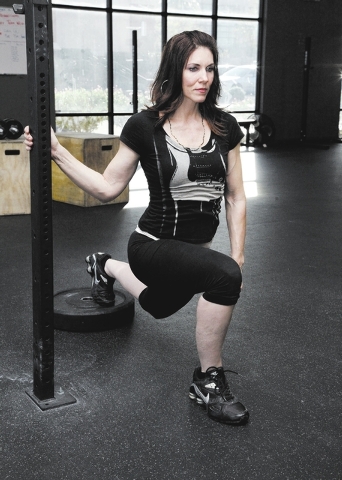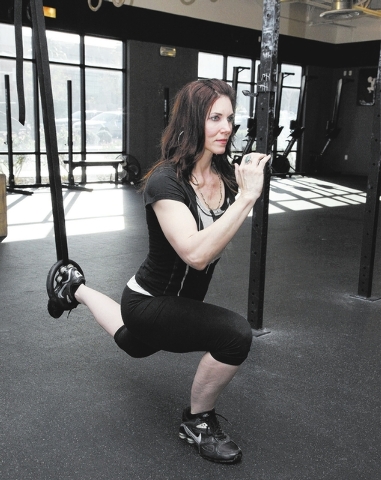Split to get fit: One-legged squats boost balance




Laura Salcedo is an accomplished trainer. She started as a group exercise instructor and has since moved into personal training.
She continually learns more about her craft and often poses for the Las Vegas Review-Journal’s Health section.
During a photo shoot, I asked her which exercises she favors in training her athletes. In response, she recommended the split squat.
At first glance it looks similar to a lunge. However, having the back foot elevated changes the stimulus. The body is forced to rely predominantly on the front leg for stability and strength.
A lunge distributes the body’s weight more evenly across both legs.
Split squats are a unilateral exercise that lets Laura do many things at once. Since most people are more stable on two legs, using only one leg lets the athlete’s body tell Laura which areas to emphasize during training.
Each repetition is like a minidiagnostic. If the athletes respond to Laura’s verbal cues to correct form flaws then they are in control of their body. If the knees do weird things such as crash inward, shoot forward too far or the body is too wobbly then Laura knows to address things such as balance and length tension relationship of the involved muscles. Some simple pattern training might also follow.
Split squats are great for improving balance. They provide a stable and controllable environment for the body to adapt to. Around the third or fourth set of split squats, a person begins to fatigue and balance is the first thing to go. This is a good tool to build mental toughness and see just how much control an athlete can muster.
Traditional squats performed on two legs can hide some subtle form flaws that manifest in the split squat. An athlete may have a problem with one weak ankle that shows up in a split squat.
The movement itself can help strengthen the weakness and turn it into a strength to further improve a weighted squat.
It is common for people to have different tight and weak muscles from one leg to the other. The inner thigh could be tighter on the left leg and the hip could be tighter on the right leg. This could lead to an unfavorable hip shift and knee collapse during traditional and split squats and even show up on other functional movements.
Laura, who also is a fascial stretch therapist, can quickly get performance results with a few targeted manual stretches on her stretch table. Using movements like the split squat, she can identify tight areas. After she spends some time stretching an athlete, movements almost always improve.
If you are performing split squats on your own, Laura recommends a few areas to focus on. The first is your front knee. Your shin should be vertical, which will keep your knee behind your toe. This ensures you don’t overload your knee. Your body weight should be on your hips.
Be sure your knee is in line with your toe. If you are at the bottom of a split squat and your knee is rotated inward, you are not creating torque in your hip socket. This means you are stability hunting on your tendons and ligaments instead of being in control.
Be safe and push the knee outward. Keep the torso tall during your split squats. As people tire, they tend to lean forward. This shifts the center of gravity forward and puts unnecessary load on the knee. It is also a sign of a weak core.
So keep the chest tall on the way up and on the way down.
Progressing the split squat is simple. You can either add weights by holding dumbbells in both hands or change the back foot’s balance point. Raising the step the back foot rests on is a simple, effective way to make this exercise tougher.
You also can put your back foot in a suspension trainer such as the black and yellow TRX Suspension Trainer or an Olympic ring that has been lowered to a comfortable level. See the video online at www.lvrj.com/trainer for the walk-through.
Chris Huth is a Las Vegas trainer. He can be reached at 702trainer@gmail.com. Consult your physician before beginning any exercise program.












